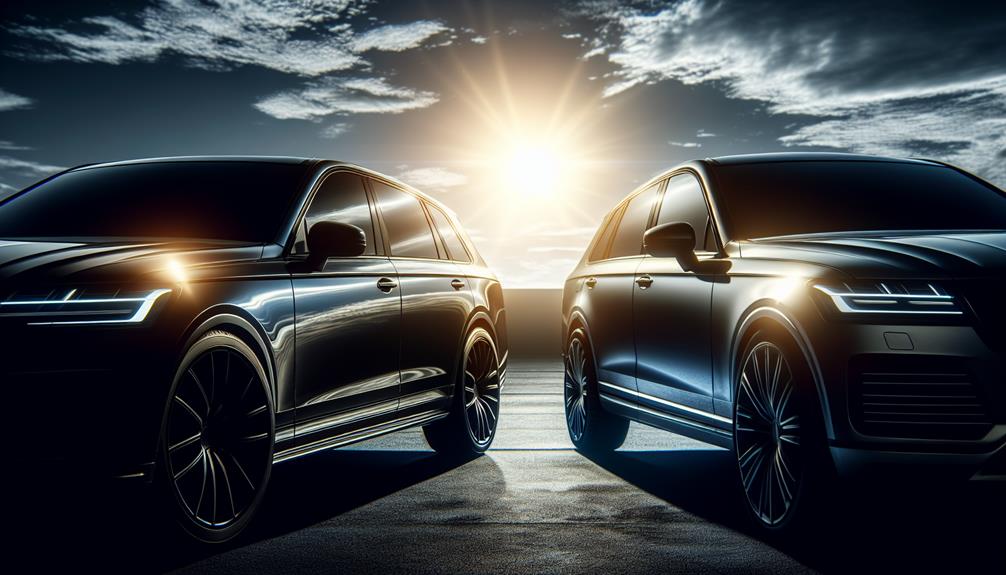The Pros and Cons of Dyed Window Tint: Is It Right for Your Car?

When considering dyed window tint for your vehicle, it is imperative to weigh both its aesthetic benefits and functional limitations. This type of tinting film, known for its cost-effectiveness and ability to reduce glare and heat absorption via a layer of dye between the adhesive and a protective top coating, offers a matte finish that enhances privacy during daylight hours. However, its susceptibility to fading from UV exposure and lesser efficacy in heat rejection compared to metallic or ceramic tints are significant disadvantages. Furthermore, the reduced effectiveness in low-light conditions may affect nighttime driving visibility. Thus, evaluating these aspects, including auto glass tinting, is crucial in determining whether dyed window tint aligns with your vehicular needs and preferences, prompting a deeper examination of alternative tinting solutions.
Benefits of Dyed Window Tint
Why consider dyed window tint for your vehicle or building? Dyed window tints are crafted through a process wherein a layer of dye is applied between the protective outer layer and the adhesive that bonds to the glass surface. This method offers a unique blend of benefits, notably its capacity to absorb solar heat. The dyes in the film capture and retain solar energy, effectively reducing the heat entering the interior, which can significantly enhance comfort and reduce the need for air conditioning, thus leading to energy savings.
Moreover, dyed window tint provides a non-reflective finish that offers a sleek, uniform appearance from the exterior. This feature is particularly beneficial for those seeking to maintain a classic aesthetic without the mirror-like appearance of some other tinting materials. Additionally, it ensures privacy by limiting visibility into the vehicle or building while still allowing for good visibility from the inside out during both day and night.
This type of tint also blocks harmful ultraviolet rays from the sun, which can protect the interior materials from fading as well as safeguard the skin of the occupants. By choosing dyed window tint, individuals join a community prioritizing both aesthetic appeal and protective functionality.
Drawbacks of Dyed Window Tint
Despite the numerous advantages of dyed window tint, it also presents several limitations that warrant consideration.
Primarily, the durability of dyed tints is less robust compared to other types of window films. The dye in the film can degrade over time, especially under consistent exposure to sunlight, leading to fading and a loss of efficacy in UV blocking. This degradation not only diminishes the aesthetic appeal but also reduces the functional benefits, compelling car owners to replace the tint more frequently than metallic or ceramic tints.
Moreover, dyed window tints offer inferior heat rejection properties. The construction of dyed tints focuses mainly on light absorption, not on reflecting heat. Consequently, while they can reduce glare and block UV rays, they are less effective at controlling the interior temperature of a vehicle. This can result in a higher reliance on air conditioning, which in turn increases fuel consumption and can strain the vehicle’s engine.
Another notable drawback is the limited privacy after dark. Dyed tints maintain a consistent shade, which provides less privacy at night compared to during the day. This characteristic might concern those who prioritize privacy as a key feature of window tinting.
In sum, while dyed window tint beckons with its cost-efficient allure and aesthetic enhancement, it carries with it shadows of impermanence and limited functionality.
As the sun sets on its durability and the tint fades like a dimming twilight, car owners must weigh the ephemeral beauty against the enduring demands of protection and privacy. Including auto glass tinting in your considerations can provide a broader perspective on available options and their benefits.
Thus, the decision to embrace dyed window tint is a delicate balance, akin to choosing between a fleeting mirage and a steadfast shelter.